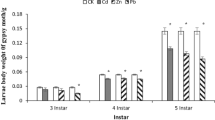Abstract
Redlegged earth mites (Halotydeus destructor) aggregated in larger numbers on cotyledons of subterranean clover (Trifolium subterraneum L.) previously damaged either by mite feeding or by mechanical injury than on undamaged cotyledons. This effect lasted for up to 7 days. The total volatile fractions derived from crushed cotyledons and its three major components, 2-(E)-hexenal, 1-octen-3-ol, and 1-octen-3-one, were tested for their effect on the aggregation of mites. Significantly more mites gathered on detached cotyledons treated with the metabolites at low concentrations than on controls, with 2-(E)-hexenal being the most effective. Mites were repelled by higher concentrations of the metabolites and 1-octen-3-one, the most active, killed mites at high concentrations. Fewer mites aggregated on DGI007 (resistant) than on Dalkeith (susceptible) cotyledons treated with droplets of the metabolites. The three volatile metabolites were recovered from the headspace of undamaged and of damaged cotyledons. Crushed cotyledons of Dalkeith produced higher levels of 2-(E)-hexenal and lower levels of 1-octen-3-one than undamaged cotyledons. The results suggest that damage-induced metabolites enhance the aggregation of redlegged earth mites at low concentrations and reduce aggregation at high concentrations.
Similar content being viewed by others
REFERENCES
ANDERSEN, R. A., HAMILTON-KEMP, T. R., HILDEBRAND, D. F., MC CRACKEN, C. T., JR., COLLINS, R. W., and FLEMING, P. D. 1994. Structure-antifungal activity relationships among volatile C6 and C9 aliphatic aldehydes, ketones, and alcohols. J. Agr. Food Chem. 42:1563–1568.
BLAAKMEER, A., GEERVLIET, J. B. F., VAN LOON, J. J. A., POSTHUMUS, M. A., VAN BEEK, T. A., and DE GROOT, A. 1994. Comparative headspace analysis of cabbage plants damaged by two species of Pieris caterpillars: Consequences for in-flight host location by Cotesia parasitoids. Entomol. Exp. Appl. 73:175–182.
CROFT, K. P. C., JUETTNER, F., and SLUSARENKO, A. J. 1993. Volatile products of the lipoxygenase pathway evolved from Phaseolus vulgaris (L.) leaves inoculated with Pseudomonas syringae pv phaseolicola. Plant Physiol. 101:13–24. ai]DE LUMEN, B. O., STONE, E. J., KAZENIAC, S. J., and FORSYTHE, R. H. 1978. Formation of volatile flavor compounds in green beans from linoleic and linolenic acids. J. Food Sci. 43:698–708.
DICKE, M., and SABELIS, M. W. 1992. Costs and benefits of chemical information conveyance: Proximate and ultimate factors, pp. 122–155, in B. D. Roitberg and M. B. Isman (eds.). Insect Chemical Ecology, an Evolutionary Approach. Chapman & Hall, New York.
DICKE, M., VAN BEEK, T., VAN POSTHUMUS, M. A., BEN DOM, N., VAN BOKHOVEN, H., and DE GROOT, A. E. 1990. Isolation and identification of volatile kairomone that affects acarine predator prey interactions: Involvement of host plant in its production. J. Chem. Ecol. 16:381–396.
GARDNER, H. W. 1991. Recent investigations into the lipoxygenase pathway of plants. Biochim. Biophys. Acta 1084:221–239.
HATANAKA, A. 1993. The biogeneration of green odour by green leaves. Phytochemistry 34:1201–1218.
HILDEBRAND, D. F., RODRIGUEZ, J. G., LEGG, C. S., BROWN, G. C., LUU, K. T., and VOLDEN, C. S. 1986. Peroxidative responses of leaves in two soybean genotypes injured by two spotted spider mites (Acari: Tetranychidae). J. Econ. Entomol. 79:1459–1465.
JIANG, Y., and RIDSDILL-SMITH, T. J. 1996. Antixenotic resistance of subterranean clover cotyledons to redlegged earth mite, Halotydeus destructor (Acarina: Penthaleidae). Entomol. Exp. Appl. 79:161–169.
JIANG, Y., GHISALBERTI, E. L., and RIDSDILL-SMITH, T. J. 1996a. Correlation of 1-octen-3-one with antixenotic resistance in subterranean clover to the redlegged earth mite (Halotydeus destructor) (Acarina: Penthaleidae). J. Chem. Ecol. 22:369–382.
JIANG, Y., RIDSDILL-SMITH, T. J., and GHISALBERTI, E. L. 1996b. Assays for the effects of volatile compounds from damaged cotyledons of subterranean clover on the redlegged earth mite, Halotydeus destructor. Exp. Appl. Acarol. 20:61–72.
KASU, T., BROWN, G. C., and HILDEBRAND, D. F. 1994. Application of fatty acids to elicit lipoxygenase-mediated host plant resistance to two spotted spider mites (Acari: Tetranychidae) in Phaseolus vulgaris L. Environ. Entomol. 23:437–440.
OHTA, H., SHIDA, K., PENG, Y. L., FURUSAWA, T., SHISHIYAMA, J., AIBARA, S., and MORITA, Y. 1990. The occurrence of lipid hydroperoxide decomposing activities in rice and the relationship of such activities to the formation of antifungal substances. Plant Cell Physiol. 31:1117–1122.
RIDSDILL-SMITH, T. J., and GILLESPIE, D. J. 1993. Assays for the study of subclover resistance to redlegged earth mite, pp. 326–329, in S. A. Corey, D. J. Dall, and W. Milne (eds.). Pest Control and Sustainable Agriculture. CSIRO, Australia.
SLUSARENKO, A. J., CROFT, K. P., and VOISEY, C. R. 1991. Biochemical and molecular events in the hypersensitive response of bean to Pseudomonas syringae pv. phaseolicola, pp. 126–143, in C. J. Smith (ed.). Biochemistry and Molecular Biology of Plant-Pathogen Interactions. Clarendon Press, Oxford.
VICK, B. A., and ZIMMERMAN, D. Z. 1987. Oxidative systems for modification of fatty acids: The lipoxygenase pathway, pp. 54–90, in P. K. Stumpf and E. E. Conn (eds.). The Biochemistry of Plants. Vol. 9. Lipids: Structure and Function. Academic Press, New York.
ZERINGUE, H. J., JR., and MC CORMICK, S. P. 1989. Relationships between cotton leaf derived volatiles and growth of Aspergillus flavus. J. Am. Oil Chem. Soc. 66:581–585.
Author information
Authors and Affiliations
Rights and permissions
About this article
Cite this article
Jiang, Y., Ridsdill-Smith, T.J. & Ghisalberti, E.L. The Effect of Volatile Metabolites of Lipid Peroxidation on the Aggregation of Redlegged Earth Mites Halotydeus destructor (Acarina: Penthaleidae) on Damaged Cotyledons of Subterranean Clover. J Chem Ecol 23, 163–174 (1997). https://doi.org/10.1023/B:JOEC.0000006352.68072.22
Issue Date:
DOI: https://doi.org/10.1023/B:JOEC.0000006352.68072.22



